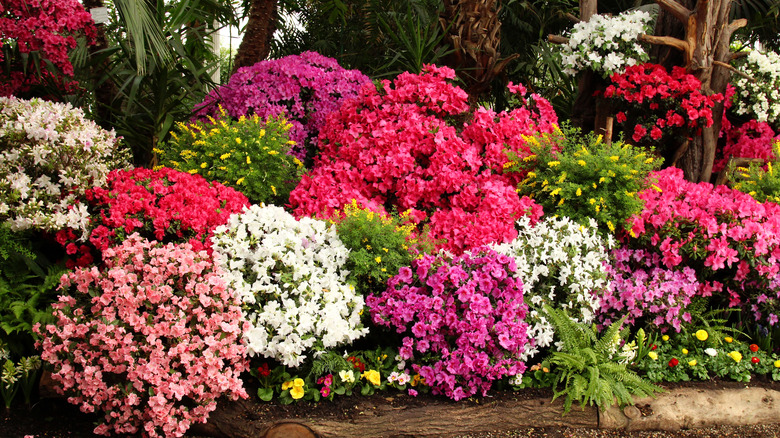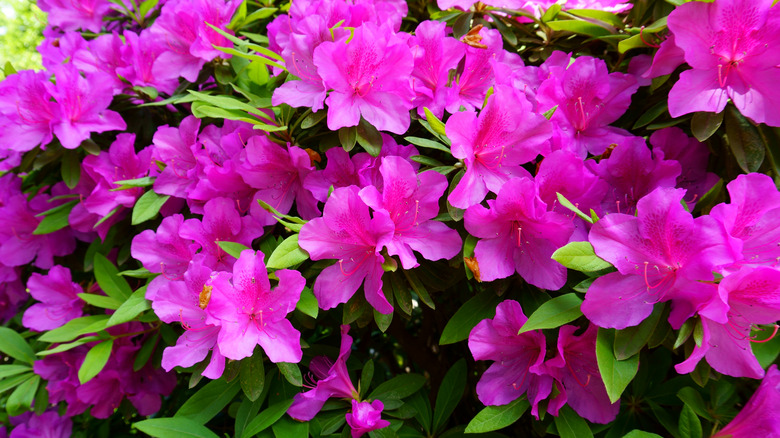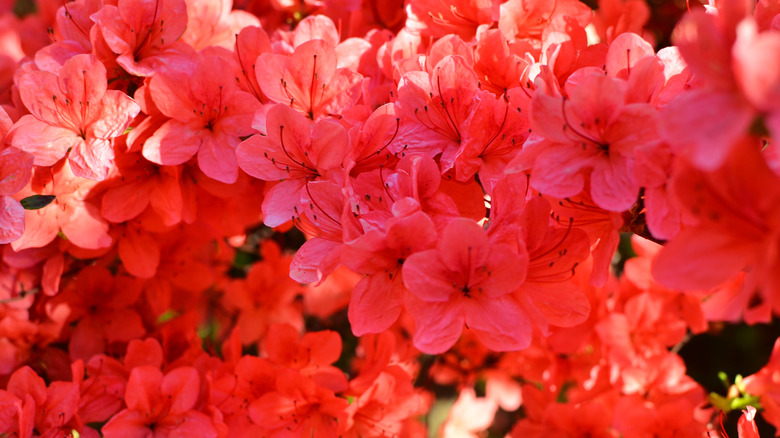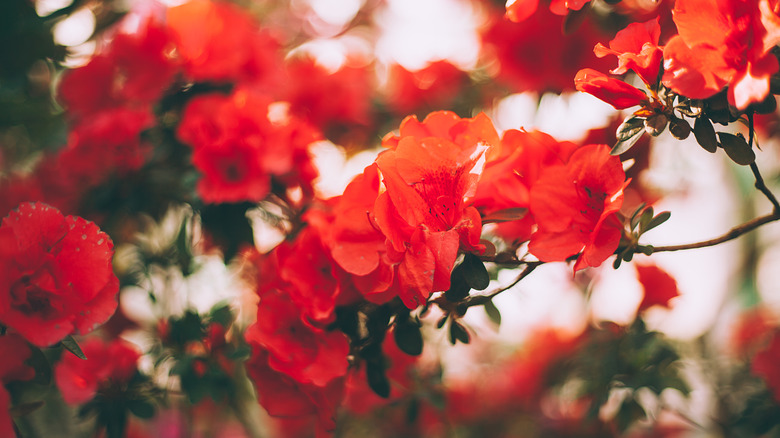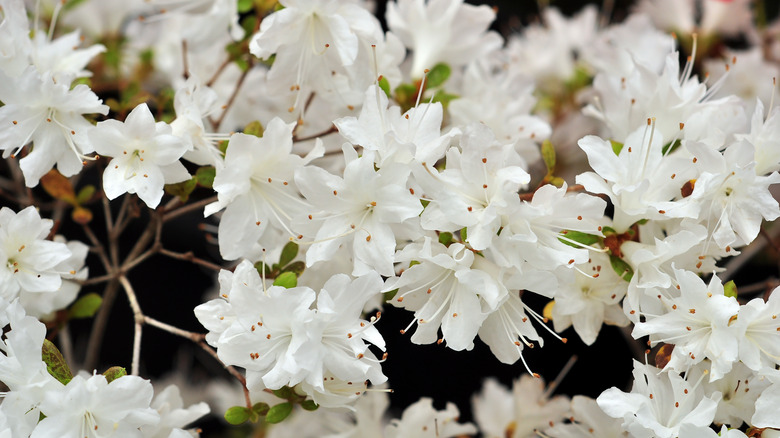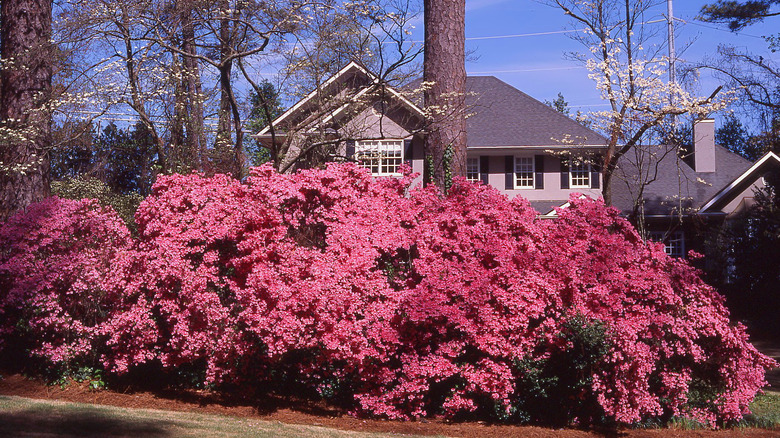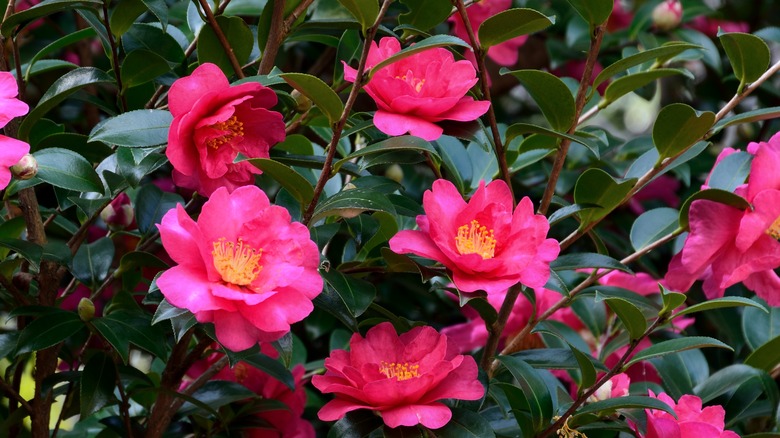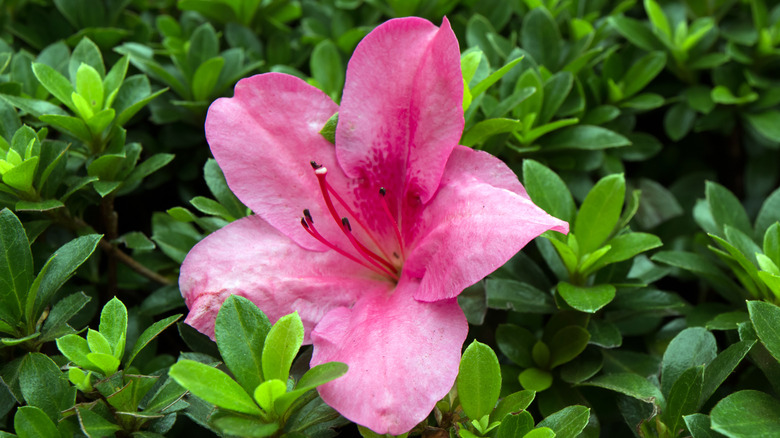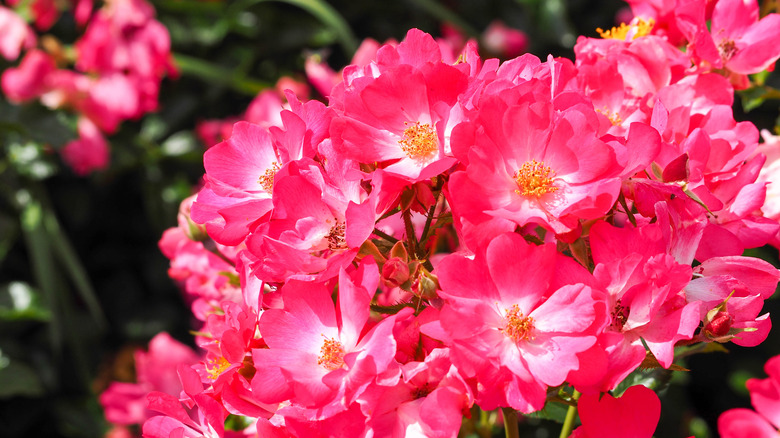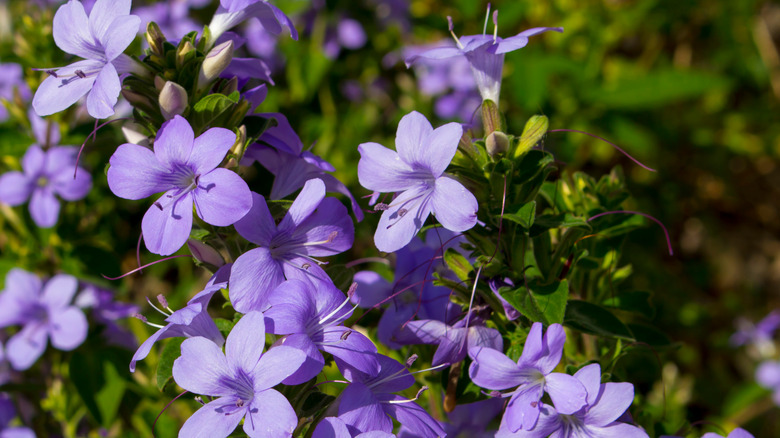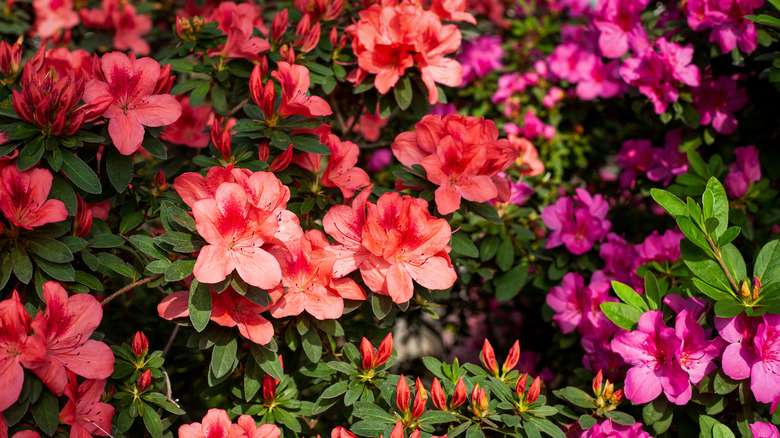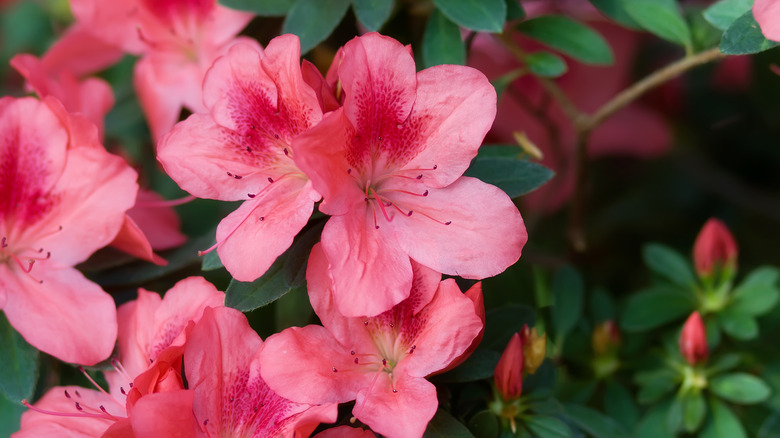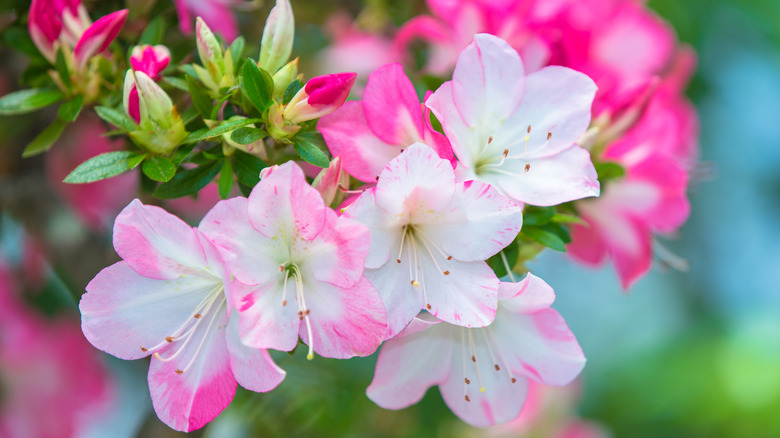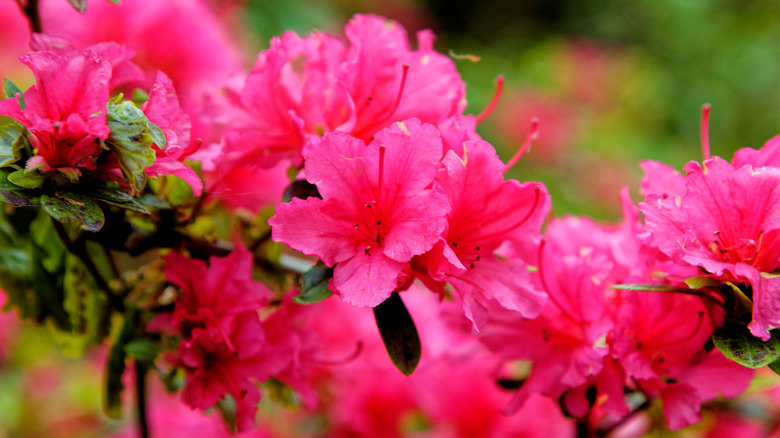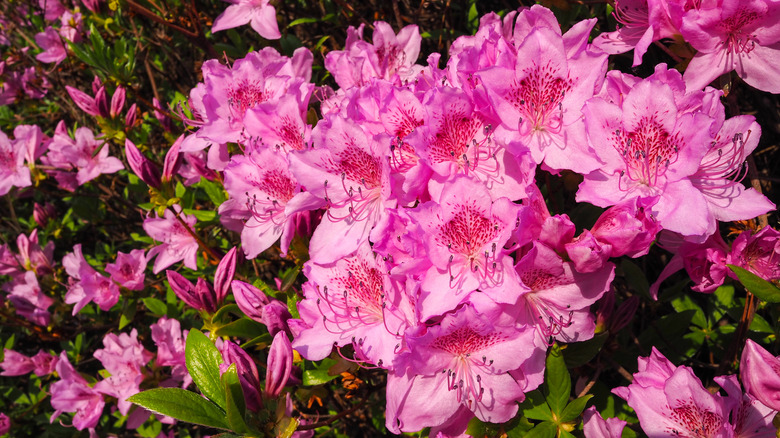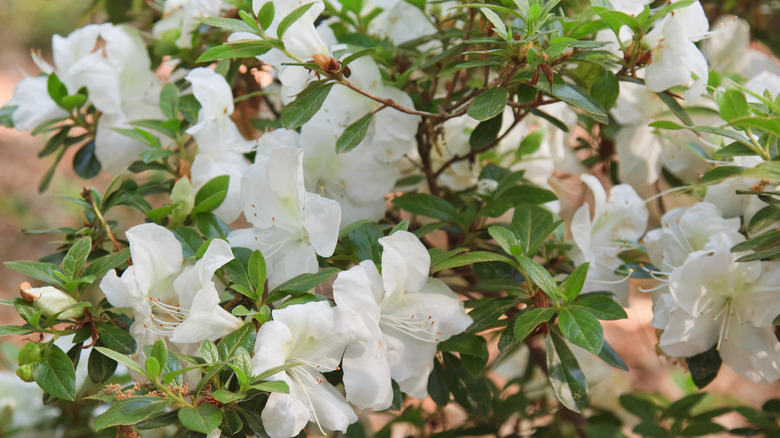15 Types Of Azaleas You Can Grow In Your Garden
Nothing says spring quite like azalea flowers! This flowering shrub of the Rhododendron genus is a favorite in Southern regions of the United States. In fact, if you've ever been to the south during the spring season, you've definitely seen quite a few. They aren't uncommon either since, according to Home Stratosphere, there are over 10,000 types of azaleas and around 800 species. Although they are mostly found in the south, azaleas are known for their hardiness and can be grown quite easily anywhere. They are widely known and well-loved for their sweet smell and vivid colors that can make any home feel fresh and lively.
Some azaleas are evergreen, with leaves that remain all year, but more common are the deciduous varieties, with leaves that shed annually each fall and grow back in the spring. However, for the purpose of a year-round home landscaping scheme, we've compiled a list of the best evergreen azaleas for your garden. In terms of maintenance, the two most important things to know are that azaleas thrive in partial shade and prefer rich, acidic soil with a pH between 4.5 and 6.0. Another impressive quality of azaleas is that although they can be grown from seeds, they can also be propagated from cuttings to produce an exact replica.
1. Formosa
A variety of the Southern Indica species of azalea, Formosas are a magenta color and often reach 7 to 10 feet in height. Like the other varieties listed below, the Formosa keeps its leaves all year long, making it an evergreen plant. This azalea can survive in USDA zones 7 to 10, as Plant Addicts explains that is not too bothered by the cold. It does, however, thrive in partial to full sun. A great perk to having a Formosa azalea is that its beautiful color and shape also attract hummingbirds, which help pollinate.
2. Stewartstonian
This azalea, a member of the Gable hybrid group, is a lower-growing shrub reaching only 5 feet at most. While the Stewartstonian's flowers are a bright orange color, its leaves are a deep green and tend to change to a chocolate-reddish color during winter, according to The Spruce. If you live in a colder area, this is a good choice of azalea, as Stewartstonians do particularly well in cooler temperatures. You should, however, be ready to commit, as this kind of azalea can last well over 40 years.
3. Fashion
Against its rich green foliage, this small-sized azalea grows red to dark orange to light salmon-colored blooms. As part of the Glen Dale hybrid group of azaleas, Fashions tend to be pretty cold-hardy and can grow in USDA zone 6 locations. It does need heavy shade to reach its full maturity at about 5 feet tall, according to Gardening Know How. A great feature of the Fashion azalea is that it blooms not only in the spring but also in fall and winter, which guarantees a colorful effect nearly all year long.
4. Glacier
The large white flowers of the Glacier azalea are what makes it so popular amongst plant lovers. On top of that, the Glacier can be planted almost anywhere, as it's very cold hardy. If possible, this azalea should be planted in full sunlight to thrive and grow to its mature height of 5 feet. Like most azaleas, the Glacier will need regular watering and rich, well-draining soil, as specified by Great Plant Picks.
5. Coral Bells
This pink variety of azalea is part of the Kurume hybrid group and is considered to be quite a favorite. The Coral Bells were imported from Japan to the United States starting in the early 20th century by the Domoto brothers, and since then, they have become a staple. In fact, its coral-pink blossoms are among the most unique in appearance, as they look like flowers within flowers laying against gray-green foliage. According to SFGate, this low-growing shrub will only extend 3 feet in both height and width.
6. Cleopatra
Named after an Egyptian queen, this azalea is as original as you can imagine, having flowers of two different colors: pink and yellow. However, unlike how a queen might behave, the Cleopatra azalea is pretty low maintenance, according to Backyard Gardener. It can thrive in either partial sun or partial shade, and can tolerate both moist and well-draining soil. Once it's been planted in a suitable location and receives occasional watering, not much else needs to be done. Its blooms will arrive in mid-to-late spring for you to enjoy with minimal effort.
7. Higasa
The slow-growing Hisaga shrub is the perfect size for any backyard. It reaches about 3 feet tall according to Monrovia, and could even be grown indoors in a container for some extra greenery in your home. It does, however, need partial sun, so make sure to place it strategically whether indoors or out. If you want to see its beautiful pink flowers bloom in the spring, water your Hisaga about once a week, or more often in cases of excessive heat.
8. Rosebud
Winner of the Rhododendron of the Year Award in 1972, the Rosebud is definitely a crowd favorite. This mid-to-late spring bloomer grows rosy-pink flowers so big that, according to Gardenia, they tend to obscure the leaves and branches. Best of all, the effect can last up to six weeks. The Rosebud spreads out rather wide, but likely won't grow over 3 feet tall. It works great as a hedge for added privacy and will fit nicely in a small garden.
9. Autumn Amethyst
One of the over 30 varieties of azaleas in the Encore series, the Autumn Amethyst blooms twice a year: once in the spring, and once in late summer or early fall. According to The Spruce, it should be grown in partial sun to best thrive and reach its impressive height of 6 feet tall. This variety is less cold-hardy than others, so it should be avoided by gardeners in colder regions. In warmer climates, it will attract pollinators such as hummingbirds, bees, and butterflies. Like the Rosebud, its flowers completely cover the plant when in full bloom.
10. Hinodegiri
This vivid purplish-red Hinodegiri azalea is part of the Kurume azalea group and blooms from late March to mid-April. Like most azaleas, it was imported from Japan around the early 20th century, along with the other evergreen Kurume varieties. The Hinodegiri can grow up to 4 feet which is fairly average. More uniquely, its light green leaves may fade to burgundy during the fall and into winter, explains Oregon State University. Ideally grown in sheltered locations, this azalea is perfect for a container and in most gardens.
11. Judge Solomon
This uniquely-named Judge Soloman variety is one the most heat-tolerant of the Southern Indica azaleas. Its large, bright pink flowers cover the tree when in full bloom, and its larger size creates the perfect natural hedge. According to Wilson Bros Gardens, the Judge Solomon azalea can reach an astounding 8 feet tall, with an equal spread. Although not particularly winter hardy, this azalea can survive in USDA zone 7 locations as long as you grow them in a container and bring them indoors once temperatures begin to drop.
12. Shinnyo-no-Tsuki
As part of the Satsuki azaleas, the Shinnyo-no-Tsuki has large, showy blooms that emerge from May to June. One of the most popular varieties, this azalea produces a stunning array of flowers with pink and white variegated petals, making it perfect for highly-visible areas such as your front yard or entryway. Although it seems to handle sunlight better than other varieties, be careful not to expose it to too much heat or direct sunlight, per Backyard Gardener. It will be much happier in a slightly shadier part of your yard.
13. Morning Star
Though more likely to stay on the short side, the Morning Star azalea can occasionally reach up to 6 feet. This Glen Dale hybrid is one of the more cold-hardy varieties, as it's able to thrive in USDA zones 6 to 9. According to Backyard Gardener, the Morning Star has dark rose-colored flowers that can grow quite big, and that usually bloom between late April and early June. Partial shade or filtered light is best for this azalea to grow in a healthy way.
14. Purple Splendor
The Purple Splendor azalea is a slow-growing shrub that prefers shaded areas. It is relatively cold-hardy, but its gray-green leaves will likely turn a yellow color in winter. It will usually grow only about 4 feet tall but extends outward to 5 feet in width, according to Plants 4 Home. The flowers that stem from this plant are magenta or purple, and usually attract all types of pollinators when it blooms from April to May.
15. Autumn Angel
Last but not least, we have the Autumn Angel azalea. Also from the Encore series, it has beautiful white flowers that remain all throughout the growing season. This variety is particularly loved for the striking contrast between the dark green foliage and pure white blossoms. FastGrowingTrees.com explains that this azalea prefers warmer climates, as it is not very cold-hardy and thrives in partial to full sunlight. Perfect for small locations, the Autumn Angel will grow just 3 feet tall and equally as wide.
